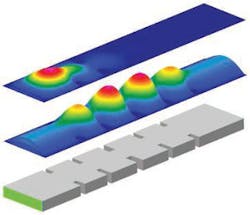EM Analysis Software Speeds Design While Beefing Up FDTD Simulation
Oxford, England: Cobham Technical Services has debuted a new version of its Concerto electromagnetic (EM) design software for RF and microwave applications. Dubbed Concerto v7.5R1, it incorporates enhancements to the three-dimensional (3D) geometric modeler that forms a part of all Concerto configurations. Specifically, this version provides new meshing options for the finite-element (FE) eigenvalue solver, which promises to shorten processing times. In addition, the modeler offers access to a range of features in Concerto's finite-difference-time-domain (FDTD) simulation engine (Fig. 1). From a single time-domain analysis, for example, it can present frequency-domain field plots over any model regions and for any number of frequencies.
In addition, the modeler can support the simulation of complex materials in FDTD. One new feature allows the definition of lumped ports with frequency-dispersive properties based on the Drude, Debye, and Lorentz models. The modeler can represent discrete structures within complex materials as circuit-element models as well. Metamaterials are one example where such circuit-element representations are useful, as they are being developed for use in microwave devices like antennas and filters. Because these types of materials generally rely on small-scale structures for their desired EM characteristics, simulation of such minute structures can prove computationally intensive. Using the bulk properties of these materials can dramatically increase simulation speed (Fig. 2).
One common application of Concerto is in antenna design. A new tool in the modeler enables swept far-field results to be generated by the FDTD solver in arbitrary directions. As a result, broadband far-field performance can be assessed both on and off antenna boresight.
In addition, Concerto's flexible scripting capability enables the automation of almost all of the features of model-creation analysis and post-processing. This latest release extends the range of commands and features in the scripting language. It also provides a redesigned and enhanced editor for creating and editing command files.
An FDTD simulator is included as a standard feature with the EM software, enabling users to model a variety of microwave devices like antennas, waveguides, filters, cavities, and resonators. Two further simulation options also are available. A method-of-moments (MoM) analysis module uses a formulation for the analysis of arbitrary geometries. Typical applications include radar-cross-section (RCS) calculations and the evaluation of antenna performance and placement on aircraft and ships.
For designers needing to characterize the performance of devices like RF cavities and microwave resonators, the system offers a finite-element-method (FEM) analysis module. It determines the eigenvalues and associated eigen vectors of resonant structures.
Concerto v7.5R1 is available in a number of configurations, including several low-cost versions. All versions use the 3D geometric modeler to build or import models while employing the FDTD engine as the standard solver. These versions can be upgraded to the full professional version. Concerto ES is an entry-level 3D package, which is well suited to designers who are new to virtual prototyping software. Its sibling, Concerto 2D, is a fast two-dimensional (2D) analysis module. It is primarily intended for designing components with axisymmetric geometries, such as circular and corrugated horn antennas.
About the Author
Paul Whytock
Editor-in-Chief
Paul Whytock is European Editor for Microwaves & RF and European Editor-in-Chief for Electronic Design. He reports on the latest news and technology developments in Europe for his US readers while providing his European engineering audience with global news coverage from the electronics sector. Trained originally as a design engineer with Ford Motor Co., Whytock holds an HNC in mechanical, electrical, and production engineering.
